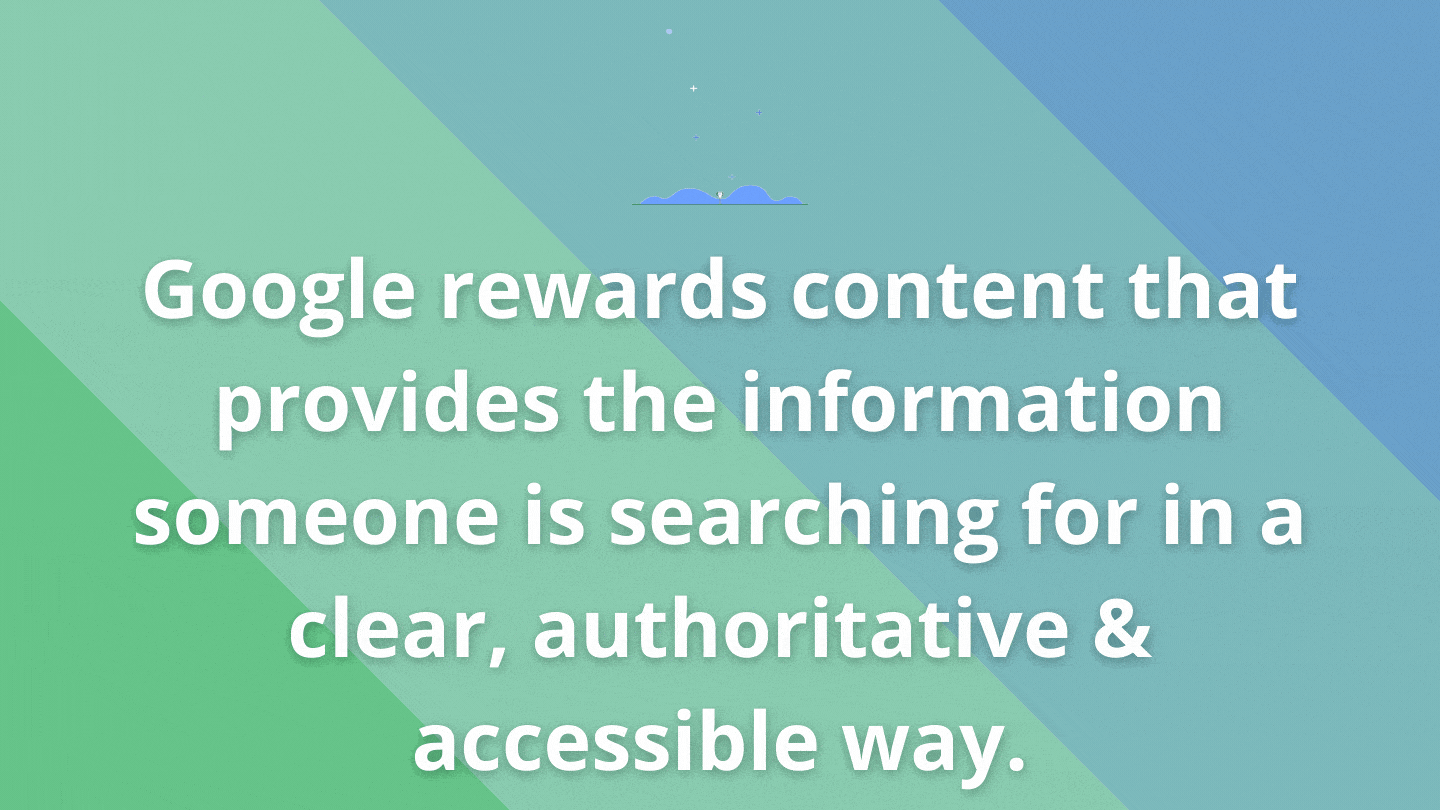SEO has changed dramatically over the years. Many marketers today find it challenging to write content that satisfies the current version of Google’s algorithm, while also appealing to users. As a result, many struggle to write SEO content.
However, there are several tips that can help marketers write content that’s both optimized for Google and compelling to users. The 5 guidelines below can help you create meaningful, engaging content with strong SEO value.

1. Be Helpful
The most important thing marketers can do when writing SEO content is to be helpful to the user.
Long gone are the days of stuffing exact match keywords into content wherever possible. Instead, Google has become much more adept at recognizing context and intent. Therefore, the exact words you use are not nearly as important as developing useful, thorough, and valuable content.
In order to develop helpful content:
- Anticipate questions users may have relating to the topic of your blog or web page
- Answer these questions in clear, easily understandable language
- Be thorough
- Demonstrate expertise by being accurate
- Focus on providing value rather than selling a specific product or service
Why is writing helpful content so important for SEO?
Google wants to serve up content that satisfies user intent, meaning it gives people the information they’re looking for. Thus, Google rewards content that provides the information someone is searching for in a clear, authoritative, and accessible way.
Plus, when you help people find the information they’re looking for, it has benefits for your business. Helpful content builds trust between your brand and your audience.
This can lead to engagement such as following you on social media, signing up for an email newsletter, inquiring about your services, browsing your product pages, and more.
In other words, when you write helpful content, both Google and users will reward you for it.

2. Identify Target Keywords
While being helpful is the ultimate goal of content creation today, it’s still important to target specific keywords in your writing. Identifying primary and secondary keywords allows you to hone in on your topic and keep your content focused on the specific questions users want answered.
You don’t need to force target keywords into every paragraph. Instead, focus on providing a wealth of information around your primary keyword. Use natural language that incorporates different variations of the target keyword or phrase.
Additionally, don’t just target one keyword when writing SEO content. Incorporate secondary keywords as well. These are sub-topics that relate to your primary keyword and overall theme of the page. Oftentimes, these are longer tail keywords or questions that people searching for the primary keyword may also want to know.
For example, say your primary keyword is “how to choose the best coffee machine.” This will be the main topic of your content. However, you can also address related sub-topics like “best coffee makers for occasional use,” “hi-tech coffee maker features,” and so on. These are secondary keywords that can be used as sub-headings to make your content more comprehensive.
By expanding on your main topic and addressing related questions, your content will encompass a broader range of keywords. This can not only help you rank for a wider variety of queries, but it also reinforces your expertise on the subject, making your content more authoritative.
To identify target keywords, there are several research tools available such as SEMRush or WordStream’s free keyword tool.
Furthermore, a great way to identify secondary keywords is to simply conduct Google searches. Search for your primary keyword, then browse the “people also ask” section and the related keywords at the bottom of the SERP.

3. Include Visual Content
In today’s online environment, users expect engaging visual content from brands. If your page is simply 800 words of plain text, it doesn’t matter how optimized or helpful the content is. Users will almost certainly navigate away to find a more engaging source of information.
As a result, Google will likely pick up signals that your page offers a poor experience, which can have a detrimental impact on SEO.
Thus, whether you’re writing a product page, blog post, or case study, visuals are an absolute must.
High-quality images are a good starting point. In addition, consider using gifs, videos, graphs, or scrollable slides. These visuals not only help break up text but also expand the appeal of your content.
For instance, when people are trying to learn and take in new information, some may prefer text while others prefer video. Some may be engaged by a humorous gif. Others may prefer to see charts and statistics.
Therefore, by including a variety of visuals in your content, you appeal to people with different learning styles and preferences. This helps you engage a wider array of users.
Consequently, people may stay on your page longer and engage more with your site, which sends positive page experience signals to Google. This can help boost rankings.

4. Ensure It’s Technically Sound
Although the focus of content writing has shifted much more towards context and intent, the technical aspects of SEO are still important.
For instance, a solid technical SEO foundation:
- Allows Google to more easily understand your content
- Keeps your page well organized
- Helps readability
- Can position you for featured snippets and other SERP features
- Prioritizes a strong user experience (UX)
Building a strong technical SEO foundation includes the appropriate use of subheadings, internal and external links, schema markup, image alt text, and more. In addition, it includes writing a meta description that provokes action, using transition words throughout your content, and checking for 404 errors.
Furthermore, UX is becoming more and more synonymous with SEO. Site speed and Core Web Vitals are now an integral part of a strong SEO foundation. Marketers can use tools like GTmetrix and Google PageSpeed Insights to assess a page’s performance and identify opportunities for improvement.
As previously stated, content writing has changed a lot in recent years.
However, technical SEO still serves a purpose. It can set your content up for success by, for example, organizing it logically and ensuring fast-loading pages. Technical SEO may not be as heavily emphasized as it used to be, but it’s still an important component of writing SEO content.

5. Continually Update Content
In addition to being helpful, identifying target keywords, including visual content, and ensuring a technically sound foundation, it’s important to continually update your content.
Monitoring your website traffic analytics can help you make decisions on which posts to update. For example, if one of your blog posts is not generating traffic, try making adjustments. Change the headline, swap out images, or add a new call to action to the meta description. Break up longer sections of text with visuals or bulleted lists to make it easier to read. Rewrite the intro paragraph to make it more attention grabbing. Add a link to a related blog post that might be interesting to your audience.
These tweaks may improve the effectiveness of your existing post, allowing you to increase traffic to your site without having to create new content from scratch.
Furthermore, marketers should update website pages and blog posts to reflect current information.
For instance, if a trend highlighted in one of your blog posts becomes obsolete, that content needs to be updated so users are not presented with out-of-date information. Likewise, if one of your products begins offering a new feature, you should update the product page to showcase that.
Updating your content can add value to existing posts and pages while giving users the most up-to-date and accurate information. That not only creates a better UX but also helps build your authority. Both of these are important SEO factors.
For help with copywriting or developing an SEO strategy for your business, contact Creative Website Marketing today.


I feel like the importance of user experience is so vital especially with the number of websites and online platforms that are out there at the moment. Sharing value and as you say “being helpful” is now going to be the main priority for businesses moving forward.
Thank you so much for sharing these blog